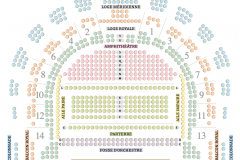Don Juan
May 2026 | ||||||
|---|---|---|---|---|---|---|
Mo | Tu | We | Th | Fr | Sa | Su |
Molière: Don Juan | Theatre
Comedy in five acts created at the Palais-Royal in Paris in 1665.
Performance in French without surtitles.
Duration: 2h30 without intermission
Beautiful disorders
By a semantic shift around the figure of the libertine, my Dom Juan will be very sadistic, very 18th-century French, with the scent of an unmade bed, an atmosphere of Dangerous Liaisons, and an elegant transgressive and pleasure-seeking cynicism. Sadistic because, like this other "great lord and wicked man," there is pleasure in doing Evil; there is the desire to display impiety and all kinds of excesses. In Dom Juan, as in Sade, two deviants share the stubbornness to "put on a theater" in all circumstances; in this fugitive character as I imagine him, pursued and holed up at home, there remains a taste for disguise and all forms of lying. The matter is set not far from the Revolution that will shatter the Old Regime and its privileges. Libertinism and the Enlightenment, the excesses of the Regency.
Dom Juan has his Sganarelle as Sade had his Latour, a mirror accomplice in his sacrilegious escapades. Love-hate between servant and master, a perverse game of domination, fascination-hate. Dom Juan as a Don Giovanni on the edge of the abyss, blasphemous, incandescent, secluded. In his den, the fire, the laundry, the shadows remain. Dom Juan has a sense of numbers, lists, and a cynical accounting of his assaults and conquests. The female body is there. To enjoy it then debase it.
As the sky is empty, it is human society that will rid itself of this bad subject who defies the course of the world, who perverts and threatens social order.
Dom Juan has killed; from the beginning, death is present as a floating presence, and the plot of his defeat tightens around him. A nearly familial conspiracy is brewing. Also brewing is a woman’s vengeance: "At least fear the anger of an offended woman."
The character of Elvire is to be revisited; powerful, ambivalent, dangerous, sublime, she is beyond grief. Here, I want to express a woman’s rebellion against a destiny assigned to humiliation and degradation by the all-powerful desire of a man. A cruel tearing from the one loved and what follows.
I stage Dom Juan after Tartuffe, which we have already played more than a hundred times, because the porosity of the two works around transgression is striking. Indeed, Molière wrote Tartuffe in three acts banned at first, then Dom Juan was stopped very early, then Tartuffe in five acts... I stage these two plays from a female perspective and through women’s eyes; where are we with seduction, betrayal? Questions about desire, predation, consent, rebellion, and the deadly game of subjugation. To speak again of pleasure to the point of Evil and the masculine mystery, facing me, which never ceases to question me.
This show is still, despite and with the tragic, the joys of a great comedy, a sparkling laughter!
Macha Makeïeff.
PRESTIGE VIP CATEGORY: The best seats in the house, the program will be offered to you along with a glass of champagne.
PRESTIGE CATEGORY: Very good seats, the program will be offered to you along with a glass of champagne.
Program and cast
Company MadeMoiselle
Xavier Gallais – Dom Juan
Vincent Winterhalter – Sganarelle
Irina Solano – Elvire, The Specter
Pascal Ternisien – Dom Luis, Monsieur Dimanche
Jeanne-Marie Lévy – A Libertine, Musician
Xaverine Lefebvre – Charlotte, A Libertine, The Commander
Khadija Kouyaté – Mathurine, A Libertine
Joaquim Fossi – Dom Alfonse, Pierrot
Anthony Moudir – Dom Carlos, Gusman
Macha Makeïeff, Director
Jean Bellorini assisted by Olivier Tisseyre, Lighting
Sébastien Trouvé assisted by Jérémie Tison and Frédéric Guillaume, Sound
Cécile Kretschmar, Makeup and Wigs
Guillaume Siard, Movement
Lucile Lacaze, Assistant Director
Laura Garnier, Costume Assistant
Programme
Comedy in five acts created at the Palais-Royal in Paris in 1665.
Performance in French without surtitles.
Production Company MadeMoiselle – Macha Makeïeff.
Co-production: Théâtre National Populaire – Villeurbanne; La Criée – National Theatre of Marseille; Châteauvallon-Liberté, national stage of Toulon; National Theatre of Nice; Le Quai – CDN Angers Pays de la Loire; Grand Théâtre de Provence.
With support from Pavillon Bosio, Higher School of Plastic Arts of Monaco.
The MadeMoiselle company is supported by the DRAC Provence-Alpes-Côte d’Azur.
Set construction and costume making: TNP workshops.
Props construction: DTMS Stage Technician Constructor of Jules Verne Vocational High School – Sartrouville.
Palace of Versailles Opera Theater
Royal Opera
The Royal Opera of Versailles, located in the grounds of the Castle, one of the major opera houses.
The opening of the opera house at Versailles brought to a close a process of planning, projects and designs that had lasted for nearly a century. While the Royal Opera was finally built towards the end of the reign of Louis XV, it had been envisaged since as early as 1682, the year when his predecessor Louis XIV took up residence at Versailles. The King had commissioned Jules Hardouin-Mansart and Vigarani to draw up plans for a ballet theatre. Mansart shrewdly decided on a position at the far end of the new wing that was to be built over the coming years: the nearby reservoirs for the gardens’ fountains could be used to fight any fire that might break out, while the sloping ground on that part of the site would allow provision of the necessary technical spaces below the stage without major excavation work. So cleverly-chosen, indeed, was the planned location that none of Mansart’s successors ever questioned it.
Major building work was already under way in 1685, but was soon interrupted because of the wars and financial difficulties which beset the later part of the king’s reign. Louis XV in his turn was long put off by the huge expense involved in the project. As a result, for almost a century the French court was forced to put up with a makeshift theatre installed below the Passage des Princes. When a grand opera was required, with a large cast and complicated stage machinery, a temporary theatre would be built in the stables of the Grande Ecurie, with the entire structure being demolished once the performances were over. This temporary solution was adopted, for instance, during the celebrations of the Dauphin’s wedding in February 1745, but its inconvenience was so starkly obvious that Louis XV finally resolved to build a permanent theatre, entrusting its design to his first architect, AngeJacques Gabriel.
The process of actually building the new theatre, however, was to take over twenty years. During this lengthy period of construction Gabriel, who had studied the leading theatres of Italy, in particular Vicenza, Bologna, Parma, Modena and Turin, presented a series of different designs to his royal patron, none of which was accepted. Only in 1768, faced with the forthcoming successive marriages of his grandchildren, did the king finally give the order for work to commence. Building progressed steadily and the new opera house was completed in twenty-three months, ready for its inauguration on the 16th of May 1770, the day of the Dauphin’s marriage to the Archduchess Marie-Antoinette, with a performance of Persée by Quinault and Lully.
Royal Chapel
This extraordinary two-level palatine chapel was built by Jules Hardouin Mansart between 1699 and 1708 and completed by Robert de Cotte in 1710.
The paintings on the vaulted ceiling by Antoine Coypel, Charles de la Fosse and Jean Jouvenet, as well as the lavish decoration fashioned by a team of sculptors working for Louis XIV, depict a number of Old and New Testament scenes. Facing the royal gallery is the remarkable organ, created by Robert Clicquot, the King's organ builder, which was first played on Easter Sunday 1711 by François Couperin.
Even though Hardouin-Mansart did not witness the completion of the chapel, he was the one who had dictated the major aspects of the architecture and decor: a ground floor with a nave, aisles and ambulatory, and an upper floor with galleries, a harmonious combination of white and gold contrasting with the polychromatic marble floor and paintings on the vaulted ceiling, all combining to create an original space with references to both gothic architecture and baroque aesthetics.
Every day, generally at 10 a.m., the court would attend the King's mass. The King would sit in the royal gallery, surrounded by his family, while the ladies of the court would occupy the side galleries. The "officers" and the public would sit in the nave. The King would only descend to the ground floor for important religious festivals when he would take communion, for Order of the Holy Spirit ceremonies and for the baptisms and weddings of the Children of France, which were celebrated there between 1710 and 1789. Above the altar, around the Cliquot organ played by the greatest virtuosos of their age, including François Couperin, the Chapel Choir, renowned throughout Europe, would sing motets throughout the entire service, every day.
The Orangerie gardens
From May to October, orange trees and other shrubs are taken out of the Parterre Bas of the Orangerie gardens. At the center of this parterre, there is a large circular pool surrounded by six sections of lawn.
Orangerie
A great stone cathedral within a formal garden, The Orangerie is both a royal and magical place.
Built between 1684 and 1686 by Jules Hardouin-Mansart to house and protect precious trees and shrubs during the Winter, this extraordinarily large building is located beneath the parterre du Midi (South flowerbed), for which it acts as a support. Two monumental staircases, known as "les Cent Marches" (the hundred steps), frame the Orangerie's three galleries, which overlook the parterre where, during the Summer, more than 1,200 exotic trees are arranged.

 EN
EN DE
DE IT
IT FR
FR ES
ES RU
RU JP
JP RO
RO
 Seating plan
Seating plan 
